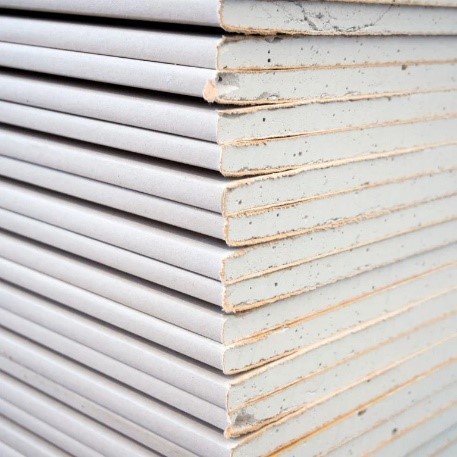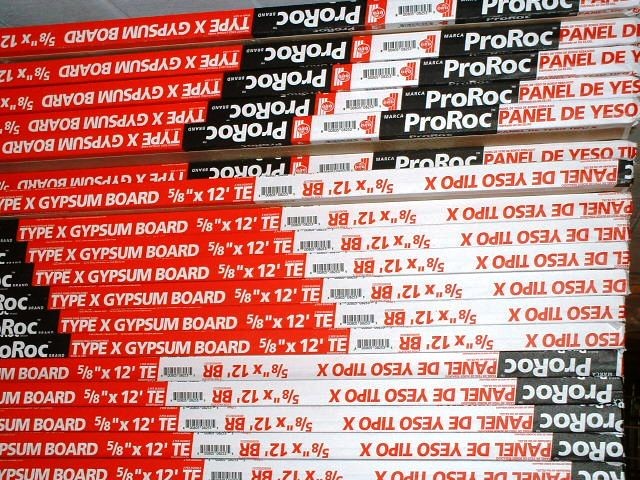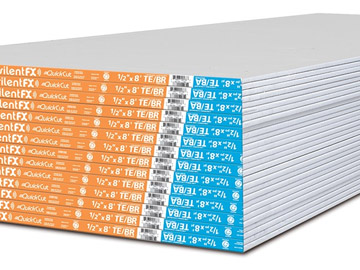What Is Drywall?
Drywall is a construction material used to create walls and ceilings. It’s also used to create many design features, including eaves, arches and other architectural specialties. It’s quick and easy to install, incredibly durable, and requires only simple repairs when damaged.
Drywall is made of gypsum (calcium sulfate dihydrate), paper, and additives such as mica, clay, and resin. Drywall installation generates gypsum and silica dust, which are irritating to the lungs.
Drywall was invented in 1916.
The United States Gypsum Corporation, a company that vertically integrated 30 different gypsum and plaster manufacturing companies 14 years prior, created it to protect homes from urban fires, and marketed it as the poor man’s answer to plaster walls.
Drywall is so popular due to many reasons. It’s affordable, first and foremost. It’s also highly flame resistant, which makes it one of the safest materials used for housing walls. It also has excellent insulation properties.
Key benefits of drywall are:
- Affordability
- Beauty & Elegance
- Insulation Properties
- Fire Resistant Properties
- Ease of Repair / Installation
Drywall Types
Regular

In regular drywall, and most other types as well, gypsum is sandwiched between two layers of paper. There is a paper on the back (usually brown) and the face, which, in the case of regular drywall, is gray. Regular drywall can be used throughout a house and comes in a number of dimensions—the most common size is a 4-foot by 8-foot sheet.
Green Drywall
 Green drywall is a type of drywall that’s mold resistant and is used in applications where moisture can be an issue—so most commonly, bathrooms. To maximize the mold resistance, use mold-resistant drywall mud, aka joint compound.
Green drywall is a type of drywall that’s mold resistant and is used in applications where moisture can be an issue—so most commonly, bathrooms. To maximize the mold resistance, use mold-resistant drywall mud, aka joint compound.
Green drywall generally costs about 20% more than regular drywall.
Purple Drywall
 Purple drywall resists moisture, mold, and mildew. It also resists scratches, scuffs, and dents, making it a good choice for high-traffic areas.
Purple drywall resists moisture, mold, and mildew. It also resists scratches, scuffs, and dents, making it a good choice for high-traffic areas.
Purple drywall is about 30% more expensive than regular drywall.
Fire-Rated
 Also known as Fireboard, or X Board. All types of drywall are inherently fire resistant; however, Type X has a higher rating than others. It comes thicker than others, and has glass fibers mixed into the gypsum to increase fire resistance.
Also known as Fireboard, or X Board. All types of drywall are inherently fire resistant; however, Type X has a higher rating than others. It comes thicker than others, and has glass fibers mixed into the gypsum to increase fire resistance.
Although it bolsters a 1-hour fire rating—it isn’t fireproof, and is 10% more expensive than regular drywall.
Sound-Dampening Drywall
 It comes at the standard thickness as regular drywall, but is layered. In between the front and back paper is a 1/4-inch layer of gypsum, followed by a membrane and then another 1/4-inch layer of gypsum.
It comes at the standard thickness as regular drywall, but is layered. In between the front and back paper is a 1/4-inch layer of gypsum, followed by a membrane and then another 1/4-inch layer of gypsum.
This increases the Sound Transmission Class (STC) and reduces noise transmission from one room to the another. This type of drywall is 400% more expensive than regular drywall.
Drywall Dimensions
All types of drywall come in standard 4-foot by 8 foot-sheets. However, they also come in other dimensions. Most of the variation in size involves length; 8-, 10-, 12- and even 16-foot sheets are available.
Longer sheets are often used to cover large areas and are usually used only by professionals. Many of these types of drywall also come in 54 inch width (4.5 feet). These are used for rooms with 9-foot ceilings. It’s not surprising that the price increase as you increase in length, for example, a 10-foot sheet might cost 25% more than an 8-foot sheet.
Some types of drywall, like Type X fire-resistant drywall, are available only with a 5/8-inch thickness. However, other types of drywall come in different thicknesses; the most common are 1/4 inch, 3/8 inch, 1/2 inch and 5/8 inch.
The most common thicknesses for general application are 3/8 inch and 1/2 inch. However, several decades ago, 1/2 inch became the industry standard.
Building Applications
The thickest option available, 5/8-inch drywall is ideal for commercial construction applications. 5/8-inch thick drywall is also referred to as firewall drywall. Its thickness makes it the ideal drywall for soundproofing in noisy buildings. 5/8-inch drywall can be used on walls, and will not sag when used on ceilings. This type of drywall is not typically used in residential homes, as it is heavier and more expensive than the other drywall options.
Prices paid for gypsum products increased 2.1% in March, more than offsetting the 1.3% decline seen in February. The PPI for all gypsum products has increased 6.3% over the past 12 months while the index for gypsum building materials (e.g., drywall) is up 6.6%.
Drywall thickness is also related to other properties of drywall, such as insulation and other protection. Thicker drywall panels offer additional benefits such as fire- and moisture-resistant qualities, as well as more effective insulation. With these concerns in mind, drywall is sold with different properties:
- Insulated — Good for rooms that don’t retain heat well. Insulated panels are typically 1/2 inch thick and have a high-strength “polyfoam” core to prevent warping.
- Fire resistant — Available in 5/8-inch panels, fire-retardant drywall is the most expensive option for this size.
- Water resistant — Ideal for kitchens, laundry rooms, basements, utility rooms, and other rooms prone to water damage.

